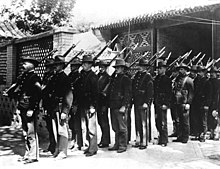China Marines
| China Marines | |
|---|---|
| North China Marines | |
 A detachment of U.S. China Marines, in a relief party, in Peiping, China, during the Boxer Rebellion of 1900. | |
| Active | 1844-1941, 1900, 1925, 1927-1941 |
| Disbanded | 1941 |
| Allegiance | |
| Branch | |
| Type | Marine Embassy Guard in Peking, China (1844-1941), 4th Marine Regiment in Shanghai, China (1927-1941) |
| Role | Protect American interests and U.S. citizens in China |
| Garrison/HQ | Shanghai, China, Peking, China, Tientsin, China |
| Motto(s) | Semper Fidelis, Gung-ho, (Marine Embassy Guards - In Every Clime and Place), (4th Marine Regiment - Hold High the Torch) |
| Mascot(s) | American Bulldog |
| Engagements | Boxer Rebellion, Chinese Northern Expedition, Chinese Civil War, Second Sino-Japanese War, World War II |
The term China Marines, also known as "North China Marines", originally referred to the United States Marines, of the 4th Marine Regiment, who were stationed in Shanghai, China from 1927 to 1941 to protect American citizens and property in the Shanghai International Settlement, during the Chinese Revolution and the Second Sino-Japanese War.[1]
Due to the cheap labor available, China Marines lived a relatively comfortable lifestyle, with each squad able to hire Chinese men to do its cleaning and run its errands. This, plus the inexpensive goods available on the local market, made assignment to the China Marines highly coveted.
Most of the China Marines were withdrawn in November 1941, but those at the embassy were scheduled to be withdrawn on December 10. However, Imperial Japan attacked the United States on December 7, and the Marine Embassy guards, plus some US Navy support personnel, a total of 204 men, were captured and held as slave labor until the war's end in August 1945. The last commander of the China Marines was Colonel William W. Ashurst.[2]
With the rapid expansion of the Marine Corps during World War II and the capture of the rest of the 4th Marine Regiment at Corregidor, the surviving China Marines were few in number and highly regarded.
After Japan's surrender, the 1st and 6th Marine Divisions, also known as China Marines, were sent to occupy northern China from 1945 to 1948.
On January 31, 1996, Marines from the 2nd Battalion 5th Marines, as part of the 31st Marine Expeditionary Unit (31st MEU), Special Operations Capable (SOC), made their first visit to Shanghai, China, since World War II. The 31st MEU-SOC visited China again on November 22, 2006, during a port visit to Zhanjiang.[3]
American Legion China Post One
American Legion China Post One, formed in 1919, one year after the "Great War" and chartered by the American Legion on 20 April 1920, was originally named the General Frederick Townsend Ward Post No. 1, China.[4] It is the only post nominally headquartered in a communist country, and has been operating in exile since 1948 — presently in Fate, Texas.[5]
In popular culture
Author W.E.B. Griffin often writes of China Marines in his book series The Corps. Book 1 of the series in particular highlights the pre-World War II lives of China Marines.
Neal Stephenson's book Cryptonomicon contains descriptions of the exploits of the China Marines in World War II. The book begins with the evacuation of Shanghai in 1941.
See also
- Yangtze Patrol
- Yangtze Service Medal
- Operation Beleaguer
- China Service Medal
- History of the United States Marine Corps
- List of United States Marine Corps battalions
References
- Biggs, Jr., Chester M. (2003). The United States Marines in North China, 1894-1942. McFarland & Company. ISBN 0-7864-1488-X.
- Shaw, Jr., Henry I. (1960). The United States Marines in North China, 1945-1949 (PDF). Washington, D.C.: Historical Branch, United States Marine Corps.

